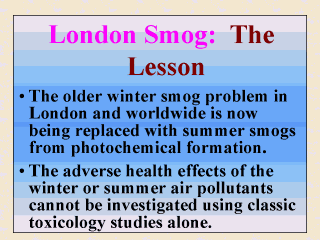 |
Winter and
summer smogs are weather-specific. Unfavorable meteorological conditions are in fact
fundamental to the adverse effects of air pollutants, which act as an agglomerate. The
once predominant sulfur dioxide in the London winter smog of 1952 is now being replaced
gradually by the fine particulates, nitrogen oxides, and carbon monoxide from vehicle
emissions. Even before the winter smogs returned in the late 1980s, London began
experiencing severe summer smogs from photochemical formation, partly due to the increased
levels of ozone occurring since the mid-1970s. As another example, Los Angeles experienced
the worst air quality in the USA in 1993, also due to high levels of ozone present in this
traffic-dense megacity (Elsom, 1996). Ozone is a strong oxidizing agent and reacts with a
range of cellular components. As a photochemical pollutant, ozone (O3) reacts
with nitric oxide (NO) to form nitrogen dioxide (NO2) and oxygen (O2):
O3 + NO ® NO2 + O2. From
this second case study, it is clear that the adverse health effects of the air pollutants
cannot be investigated through classic toxicology studies alone. As concluded by Elsom
(1996), “The polluted urban atmospheres that most of us breathe are cocktails of many
different pollutants.” Although the adverse effects of each of the major air pollutants
can be investigated effectively using one or more laboratory animal species, it is almost
impractical to purposely place the animal subjects in a controlled environment (e.g., a
chamber) where a collection of air pollutants would exert their effects exactly as if when
they were present in the urban (ambient) atmospheres. |
